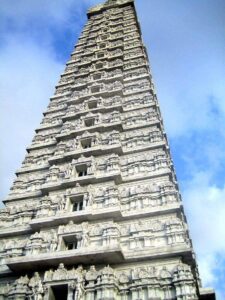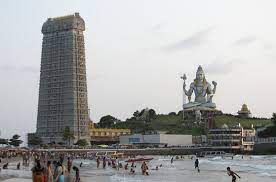According to ancient texts, temples are a place for ‘Pilgrimage or Tirtha’ that has social, economic, and spiritual significance to it. Especially in Indian culture – popular for its beliefs – temples are close to followers’ hearts. When making a list of pilgrimages in India, one of the places that should have your attention is the Murudeshwar temple.
Now, many questions may arise in your mind like What is the meaning of Murudeshwar? Where is the temple located? Who built the temple? What are the major attractions of the temple? and many more. After reading this article, you will get answers to most of your questions.
What is the meaning of Murudeshwar?
You may have heard many names of Lord Shiva; Aashutosh, Adiyogi, Bholenath, Gangadhara, Mahadeva. But Many may not know Murudeshwara is the name of Shiva as well.
Where is the temple located?
The Murudeshwara Temple in the Murudeshwara town of Bhatkal Taluk in the Uttara Kannada district of Karnataka is one such hidden gem of India. Surprisingly, very few people know that Murudeshwar houses the world’s 2nd tallest Shiva statue! The Arabian Sea is its crown; the place is just 13 Kilometers away from Bhatkal town.
The tallest Shiva statue is Kailashnath Mahadev Statue, in Nepal.
With a captivating RajaGopuram or King of towers of about 238-foot, the Murdeshwar temple has 20 floors. The charismatic temple is built on Kanduka Hill which is dedicated to Sri Lokankara and provides breathtaking views of the Arabian Sea from all three sides. Visiting Murdeshwar necessitates taking the elevator to the top of the RajaGopuram for a breathtaking view of Shiva’s statue. Devotees can also pray to Lord Shiva at the Rameshwara linga, which has its location below the hill.
The Murdeshwar temple and the RajaGopuram, as well as the Shiva statue, were a recent construction. The shrine and the 20-story Raja Gopuram are also part of the temple complex. The temple is of the shape of a square sanctuary, with tall and short kutina-style spires. The arrangement of stories is in a pyramidal pattern, with the stories gradually receding. On the top of the tower, there is a finial, a parapet with tiny shrines, and a dome-shaped cupola.

P.C: Flicker
The architecture of the Murudeshwar temple
The statue is 123 feet (37 m) in height and took about two years to build. The statue was built by Shivamogga’s Kashinath and several other sculptors, financed by businessman and philanthropist Rama Nagappa Shetty, at a cost of approximately ₹50 million. The idol is designed such that it gets the sunlight directly and thus appears sparkling.
The location of a huge statue of Lord Shiva which is the second largest statue of Lord Shiva in the world is a beautiful temple with a twenty-storied Gopuram at the entrance of the temple complex. It is around 237.5 feet tall and is the RajaGopuram. One can see a Sri Rameshwara temple at the foot of the temple. Also, a shrine dedicated to Shaneeshwara is located next to Lord Shiva’s idol, while beneath the idol there is a small cave.
The statues of two elephants guarding the temple’s entrance gate are the temple’s guardians. Within the temple grounds, there is a picture of Lord Shiva teaching Arjuna the Geeta, as well as a depiction of Ravana giving Lord Ganesha the Atma Linga. Also, Lord Bhagiratha is there in the form of Lord Shiva and the descending Ganga River from the hill.
Except for the principal sanctum, which is Sri Mridesa Linga, which is famous with the name of Murdeshwar, is in its original flavor otherwise the entire temple has been remodelled in a contemporary design. The architecture of the temple is a mixture of modern and ancient styles of the temple.
You may also like to read: SOMNATH TEMPLE GUJARAT HISTORY AND INTERESTING FACTS
P.C: wikipedia
The history of the Murudeshwara temple
The fascinating story of the temple has its links with Ramayana. Lord Shiva granted Hindu Gods invincibility and immortality because of their penance dedicated to the Atma Linga. Therefore, Ravana, King of Lanka, attempted to woo Lord Shiva by adoring him to achieve invincibility and immortality. After seeing his devotion, Lord Shiva appears and tells him to say whatever he wishes. It is then that Ravana asks for Goddess Parvathi, thus Lord Shiva grants Parvathi to Ravana.
Meanwhile, Narada muni dupes him into believing that the person accompanying him was not Parvathi and that the real Parvathi is in Pathala. Therefore, Ravana travelled to Pathala and married a king’s daughter whom he mistook for the genuine Parvathi. He sits down to meditate once more after realizing he has been duped by Narayana. Lord Shiva appears as a result of this.
This time, he requests that Lord Shiva blessed him with the precious Atma Linga, and Shiva grants his request, but with a condition to never let the Lingam be left on the ground, or all of its capabilities will return to Lord Shiva.
This made Narada realize that if Ravana obtained immortality with the Atma Linga in his hands, he would cause devastation on the earth, so he sought help from Lord Ganesha. While Ravana was on his trip to Lanka, Lord Vishnu devised a scheme to dim the Sun’s light so that it appeared to be night, forcing Ravana to conduct his evening rites and requiring him to place the Linga on the ground.
While he was contemplating Atma Ling’s curse, a Brahmin kid approached him who turned out to be Lord Ganesha. Lord Ganesha assumed this form to place the Atma Linga on the ground during the evening rites. When Ravana returned, he discovered the Linga on the ground. This enraged him, and he realized the plot. So he attempted to destroy the Lingam out of rage.
During the process, he hurled the case containing the Lingam to Sajjeshwara, a distance of 23 miles, and the lid to Guneshwara and Dhareshwara, a distance of roughly 10-12 kilometres. He also tossed the piece of fabric that covered the Atma Lingam to Mrideshwara, who was afterwards titled Murudeshwara.
You may also like to read about SHRI MAHAKALESHWAR TEMPLE-MOST SACRED PLACE
Myths and facts related to Murudeshwara temple
Having a great historical, religious as well as social significance, people often tend to associate certain myths with the Murudeshwara Temple. Let us have a look at what amazing wonders does it hide within?
- The most noticeable feature of the temple is the construction of the huge statue of Lord Shiva on which the Sun’s rays fall first.
- The statue stands at 123 feet tall and is the world’s second-highest Shiva monument. The Shiva statue took two years to complete.
- It is a belief that Lord Shiva gave the Atma Linga to Ravan as a gift for his penance, as it previously sat in Shiva’s heart.
- The cloth that covered the Atma Linga is visible in the temple. According to Hindu scriptures, all of the Gods are present.
- The temple is located on the Kanduka hill, which is flanked on three sides by the Arabian Sea, and the RajaGopuram at the entrance is 20 stories high, with spectacular views from the top.
- The temple’s main shrine contains a Deep, which still burns the same way it did during its erection.
- People pour oil into the blazing deep and see their picture in the oil to obtain God’s blessing for prosperity and good luck.
Major attractions near Murudeshwara temple
While people visit Murudeshwar temple with lots of faith and belief in heart, they can also find other activities and places that can arouse new hope and adventure in them. Here are few such places of attraction in and around Murudeshwar: –
-
Netrani Island: –
Netrani Island in Murudeshwar, often popular as ‘Pigeon Island,’ is a place off the coast of Karnataka. The uninhabited island of Netrani popularly is located about 10 nautical miles from the holy city of Murudeshwar. From Murudeshwar, an exciting boat trip of 70-90 minutes would take you to Netrani Island. This heart-shaped island is one of the top scuba diving destinations in the world.
-
Murudeshwara Beach: –
The picturesque beach of the same name is located on the outskirts of the famous Murudeshwar Temple. This beach, which overlooks Lord Shiva’s massive statue, is ideal for a picnic with family and friends. This beach’s sand is exceptional, with a smooth quality that is uncommon. Boat trips around the majestic Murudeshwar Temple are also available.
-
Murudeshwara Fort: –
Murudeshwara Fort surrounds the Murudeshwara temple complex that dates back to the Vijayanagara dynasty. Following that, Tipu Sultan is supposed to have repaired the fort.
-
Statue Park: –
This lovely stretch of green grass, which runs around the 15-meter tall Shiva monument, is home to a variety of floral plants, stone sculptures, and little ponds with ducks. The vista of the manmade waterfall cascading down over the boulders is breathtaking.
-
Bhatkal Beach: –
It is a beautiful beach on the Arabian Sea with a pristine coastline with coconut trees that offer a spectacular view of the surroundings.
-
Shopping in Murudeshwar: –
Murudeshwara is popular as a temple town and a tourist destination that offers a wide range of shopping opportunities. This city’s temple route is famous for its items, particularly souvenirs. People here can buy various decorative goods that they use as decorations. The idols and wall hangings on display here are pretty lovely.
Festivals celebrated at Murudeshwara Temple
The festival of Maha Shivratri, which falls in February or Phalgun is one of the prominent festivals celebrated at the Murudeshwara Temple. It is because the temple is dedicated to Lord Shiva.
The belief is that every month, the Shivaratri falls on the fourteenth day, or ‘Chaturdashi Tithi,’ of the ‘Krishna Paksha.’ On this day, devotees visit the Murdeshwar temple and pray to Lord Shiva and Goddess Parvathi. They also keep a fast and recite several Shiva bhajans. Shivaratri is significant because devotees spend the entire night at the temple chanting devotional hymns. On this day, the temple performs special poojas and hosts several events.
Karthik Purnima is another festival whose celebration is very important in the Murudeshwara temple. The celebrations take place in November or December. According to a tradition, Lord Shiva demolished the three magical cities erected by the demon Tripurasura, while another version claims that the festival commemorates the birth of Lord Shiva’s son, Sri Murugan.
You may also like to read about: THE SCIENCE BEHIND MAHASHIVRATRI- FACTS YOU DIDN’T KNOW
Timings of the Murudeshwara temple
For darshans and morning visits the Murudeshwara Temple opens at 6:00 a.m. and closes at 1:00 p.m. The performance of morning pooja takes place between 6:30 a.m. to 7:00 a.m. During the afternoon Mahapooja is performed between 12:15 p.m. to 1 p.m. Then, in the evening the temple reopens at 3 P.M. and closes at 8.30 P.M. after the night pooja.
At the temple, the performance of sevas takes place daily. Rudrabhishekam, Panchakajjaya, Bilvarchane, Navagraha pooja, and Bhasmarchane are some of the most popular.
How to reach Murudeshwara temple?
The accessibility to Murudeshwara temple is easy, i.e. through the air, train as well as road. For the people coming from the other cities in India, there are several domestic flights connecting the Mangalore International Airport. From there, you can hire a cab to travel to Murdeshwar, which is just 165 km away.
The nearest railway station to Murudeshwar temple is just 2kms away from the temple. Several trains run between Mangalore and other cities. Murdeshwar has its railway station, and the Karwar Express connects it to Bengaluru and other local cities.
Several public and commercial transportation companies provide road services. Roads connect most of the major cities of Karnataka with Murudeshwara. For example, Mangalore is just 165km, while Banglore is 455kms.

Comments